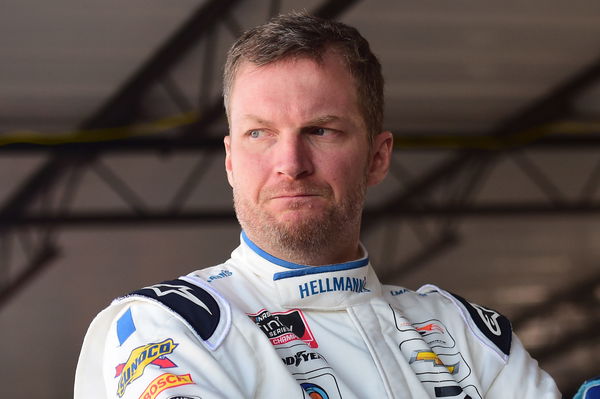
via Getty
DARLINGTON, SOUTH CAROLINA – AUGUST 30: Dale Earnhardt Jr., driver of the #8 Hellmann’s Chevrolet, stands in the garage area during practice for the NASCAR Xfinity Series Sport Clips Haircuts VFW 200 at Darlington Raceway on August 30, 2019 in Darlington, South Carolina. (Photo by Jared C. Tilton/Getty Images)

via Getty
DARLINGTON, SOUTH CAROLINA – AUGUST 30: Dale Earnhardt Jr., driver of the #8 Hellmann’s Chevrolet, stands in the garage area during practice for the NASCAR Xfinity Series Sport Clips Haircuts VFW 200 at Darlington Raceway on August 30, 2019 in Darlington, South Carolina. (Photo by Jared C. Tilton/Getty Images)
Practice sessions in the Cup Series have become practically nonexistent. Since the 2020 season, the time given to drivers and teams to get used to their cars and track conditions has significantly reduced, limited to just 20 minutes. While the underlying intention was to save money, it seems the decision hasn’t worked out the way NASCAR would have hoped, particularly for smaller teams, raising questions about the practicality of it all.
Watch What’s Trending Now!
Taking a trip down memory lane, Dale Earnhardt Jr. took to social media to reminisce about the time when NASCAR allowed over 12 hours of practice leading up to a race, a stark contrast to the circumstances present-day drivers find themselves in, which may help explain their struggles with the Next-Gen cars.
ADVERTISEMENT
Article continues below this ad
Dale Jr highlights stark contrast in NASCAR’s practice approach
Has decreasing the length of practice sessions been truly beneficial for drivers and teams? According to plenty of stakeholders in the NASCAR community, the answer is no. The sanctioning body reduced and, in some cases, eliminated practice sessions during the COVID-19 pandemic, after which they devised a very lean practice schedule as a cost-saving measure for teams. While the decision to do so was well received initially, Cup Series drivers are finding it difficult to justify in the long run, believing that the disadvantages far outweigh the benefits.
For the 500 mile race at Charlotte in 1981 there was over 12 hours of practice in the week leading up to the race on Sunday. An open practice kicked off the week the Sunday before the race. Another open practice was available Tuesday, more practice Wednesday including qualifying…
— Dale Earnhardt Jr. (@DaleJr) September 22, 2024
ADVERTISEMENT
Article continues below this ad
Many drivers and team owners believe that a limited practice session doesn’t help them make meaningful improvements to their cars. Using data to understand how the Next Gen car performs on a certain track requires extensive time, a luxury that Cup Series teams don’t have anymore. Gone are the days when drivers had an entire week to prepare for an upcoming race, devise a race strategy after running several laps, and get used to the layout to get the maximum output from their cars. Now, teams are forced to rely on simulation models to compensate for the lack of real-world practice time, which has become an additional cost that teams have been forced to invest in.
How does limited practice time affect race results? NASCAR’s ‘cost-saving’ measure affects drivers from smaller teams more than others, as they lack the resources to make improvements to their cars in such a short period. What this means is that drivers from bigger teams will always have a competitive edge, as they have the financial resources to invest in cutting-edge technology and simulators to recreate track conditions accurately. This helps them adapt to race conditions in a much more efficient way, securing better results in the process.
Brad Keselowski critical of practice time reduction
Who would know better about the pros and cons of short practice sessions than a NASCAR Cup Series team owner and a driver? In Brad Keselowski’s case, he is both, as the veteran drives the No. 6 Ford Mustang for RFK Racing, a team he co-owns alongside Jack Roush and Fenway Sports Group. While the 40-year-old has been an advocate for reducing operational costs in the past, he doesn’t believe that decreasing the length of practice sessions before a race has any financial benefits for his team.
When asked about the financial benefits of shorter practice sessions, Brad Keselowski said, “I haven’t seen how we’ve saved any money getting rid of practice, not from a team perspective. Maybe there were some savings other places in the industry that I’m not aware of. But there hasn’t been a significant cost savings. We’ve reallocated in a lot of ways to other demands, and it’s hard for me to understand the value proposition today to not have practice.” When asked if he would like additional practice time, the Michigan native replied, “Yeah, I’m more than comfortable with it.”
ADVERTISEMENT
Article continues below this ad
Would teams have invested heavily in simulators if the sanctioning body hadn’t reduced the length of practice sessions? It seems unlikely. To save costs, NASCAR has simply forced Cup Series stakeholders to transition from spending money on practice sessions to investing in technology that can recreate an environment to help drivers adapt to a racetrack more easily. However, what that does is take away something that spectators could enjoy, which seems to be a lose-lose situation for everyone involved.
Do you think NASCAR could increase the length of its practice sessions in the future? Let us know in the comments!
ADVERTISEMENT
ADVERTISEMENT
ADVERTISEMENT
ADVERTISEMENT

